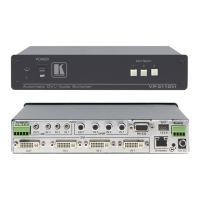Overview
KRAMER: SIMPLE CREATIVE TECHNOLOGY
2
3 Overview
The VP-311DVI is a high performance fail-safe 3x1 HDCP (high-bandwidth
digital content protection) compliant
1
automatic switcher for DVI signals,
digital audio (S/PDIF) signals, and stereo audio signals.
The VP-311DVI switches any one of three DVI-D HDCP compliant
1
sources
to a single display device, on DVI-I connectors with the corresponding:
Digital audio (S/PDIF) input signals switched to an S/PDIF output, on
RCA connectors or
Unbalanced stereo audio input signals on 3.5 mini-jack connectors
switched to an unbalanced stereo audio output on a 3.5 mini-jack
connector, as well as to a balanced stereo audio output on a 5-pin terminal
block connector
The VP-311DVI can operate either in the manual mode or in the auto mode:
In the manual mode, the VP-311DVI acts as a regular switcher, switching the
input video and audio signals to the output via the three front panel INPUT
SELECT buttons.
In the auto mode, you can switch any input to the output via the three front
panel INPUT SELECT buttons, but once the selected video signal is lost, the
machine automatically switches to the highest priority input, according to the
input priority setup
2
. The VP-311DVI will switch back to the primary input
when a DVI signal is detected on that input.
The VP-311DVI is housed in a desktop-sized enclosure and is 12 VDC fed.
Control the VP-311DVI using the front panel buttons, or remotely via:
RS-232 serial commands transmitted by a touch screen system, PC, or
other serial controller
The Kramer infra-red remote control transmitter
The ETHERNET
Remote control contact closure
1 HDCP is a standard, developed by Intel, to protect copyright holders (movie studios, and so on) from having their programs
copied and shared. The HDCP standard provides for the secure, encrypted transmission of digital signals over DVI or HDMI
connections between two HDCP-enabled devices. The source device (such as a DVD player or HDTV tuner) encrypts the
digital signal using the HDCP standard, then sends that signal over the DVI or HDMI connection to the receiving device (for
example, an HDTV). The receiving device decodes the signal using HDCP and uses the signal as it is allowed
2 As described in section 5.1

